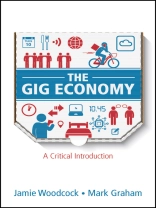All of a sudden, everybody’s talking about the gig economy. From taxi drivers to pizza deliverers to the unemployed, we are all aware of the huge changes that it is driving in our lives as workers, consumers and citizens.
This is the first comprehensive overview of this highly topical subject. Drawing upon years of research, stories from gig workers, and a review of the key trends and debates, Jamie Woodcock and Mark Graham shed light on how the gig economy came to be, how it works and what it’s like to work in it. They show that, although it has facilitated innovative new services and created jobs for millions, it is not without cost. It allows businesses and governments to generate value while passing significant risk and responsibility onto the workers that make it possible. This is not, however, an argument for turning back the clock. Instead, the authors outline four strategies that can produce a fairer platform economy that works for everyone.
Woodcock and Graham’s critical introduction will be essential reading for students, scholars and general readers interested in the massive shifts that characterize our modern digital economy.
Spis treści
Acknowledgements
Introduction
Chapter 1: Where did the gig economy come from?
Chapter 2: How does the gig economy work?
Chapter 3: What is it like to work in the gig economy?
Chapter 4: How are workers reshaping the gig economy?
Conclusion: What’s next for the gig economy?
Appendix: Draft Convention on Platform Work
Notes
References
O autorze
Jamie Woodcock is a Researcher at the Oxford Internet Institute at the University of Oxford
Mark Graham is Professor of Internet Geography at the Oxford Internet Institute at the University of Oxford












